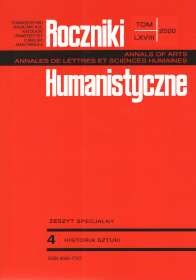Jan Reisner w Akademii św. Łukasza. Artysta a polityka króla Jana III i papieża Innocentego XI
Jan Reisner in Accademia di San Luca: The Artist and the Politics of King Jan III and Pope Innocent XI
Author(s): Tadeusz BernatowiczSubject(s): Fine Arts / Performing Arts, Architecture, History of Art
Published by: Towarzystwo Naukowe KUL & Katolicki Uniwersytet Lubelski Jana Pawła II
Keywords: Jan Reisner; Accademia di San Luca; artistic education; Polish artistic contacts with Italy; late Baroque eclecticism in architecture; King Jan III Sobieski
Summary/Abstract: Jan Reisner (ca. 1655-1713) was a painter and architect. He was sent by King Jan III together with Jerzy Siemiginowski to study art at St. Luke Academy in Rome. He traveled to the Eternal City (where he arrived on February 24, 1678) with Prince Michał Radziwiłł’s retinue. Cardinal Carlo Barberini, who later became the protector of Regni Poloniae, was the guardian and protector of the artist during his studies in 1678-1682. In the architectural competition announced by the Academy in 1681 Reisner was awarded the fi prize in the fi class, and a little later he was accepted as a member of this prestigious university. He was awarded the Order of the Golden Spur (Aureatae Militiae Eques) and the title Aulae Lateranensis Comes, which was equivalent to becoming a nobleman. The architectural award was conferred by the jury of Concorso Academico, composed of the Academy’s principe painter Giuseppe Garzi, its secretary Giuseppe Gezzi, and the architects Gregorio Tommassini and Giovanni B. Menicucci. In the Archivio storico dell’Accademia di San Luca, preserved are three design drawings of a church made by Jan Reisner in pen and watercolor, showing the front elevation, longitudinal section, and a projection. Although they were made for the 1681 competition, they were labelled with the date 1682, when the prizes were already being awarded. Reisner’s design reflected the complicated trends in the architecture of the 1660s and 1670s, especially in the architectural education of St. Luke’s Academy. There, attempts were made to reconcile the classicistic tendencies promoted by the French court with the reference to the forms of mature Roman Baroque. As a result of this attempt to combine the features of the two traditions, an eclectic work was created, as well as other competition projects created by students of the St. Luke’s Academy. The architect designed the Barberini temple-mausoleum, on a circular plan with eight lower chapels opening inwards and a rectangular chancel. The inside of the rotund is divided into three parts: the main body with opening chapels, a tambour, and a dome with sketches of the Fall of Angels. Inside, there is an altar with a pillar-and-column canopy. The architectural origin of the building was determined by ancient buildings: the Pantheon (AD 125) and the Mausoleum of Constance (4th century AD). A modern school based of this model was opened by Andrea Palladio, who designed the Tempietto Barbaro in Maser from 1580. In the near future, the Santa Maria della Assunzione in Ariccia (1662-1664) by Bernini and Notre-Dame-de-l’Assomption (1670-1676) in Paris by Charles Errard could provide inspiration. In particular, the unrealized project of Carlo Fontana to adapt the Colosseum to the place of worship of the Holy Martyrs was undertaken by Clement X in connection with the celebration of the Holy Year in 1675. In the middle of the Flavius amphitheatre, he designed the elevation of a church in the form of an antique-styled rotunda, with a dome on a high tambour and a wreath of chapels encircling it. Equally important was the design of the fountain of the central church in Basque Loyola (Santuario di S. Ignazio a Loyola). In the Baroque realizations of the then Rome we find patterns for the architectural decoration of the Reisnerian church. In the layout and the artwork of the facades we notice the influence of the columnar Baroque facades, so common in different variants in the works of da Cortona, Borromini and Rainaldi. The monumental columnar facades built according to Carlo Rainaldi’s designs were newly completed: S. Andrea della Valle (1656 / 1662-1665 / 1666) and S. Maria in Campitelli (designed in 1658-1662 and executed in 1663-1667), and Borromini San Carlo alle Quatro Fontane (1667-1677). The angels supporting the garlands on the plinths of the tambour attic are modelled on the decoration of two churches of Bernini: S. Maria della Assunzione in Ariccia (1662-1664) and S. Andrea al Quirinale (1658-1670). The repertoire of mature Baroque also includes the window frames of the front facade of the floor in the form of interrupted beams and, with the header made in the form of sections capped with volutes. The design indicates that the chancel was to be laid out on a slightly elongated rectangle with rounded corners and covered with a ceiling with facets, with a cross-section similar to a heavily flattened dome. It is close to the solutions used by Borromini in the Collegio di Propaganda Fide and the Oratorio dei Filippini. The three oval windows decorated with C-shaped arches and with ribs coming out of the volute of the base of the dome, which were among the characteristic motifs of da Cortona, taken over from Michelangelo, are visible. The crowning lantern was given an original shape: a pear-shaped outline with three windows of the same shape, embraced by S-shaped elongated volutes, which belonged to the canonical motifs used behind da Cortona by the crowds of architects of late Baroque eclecticism. Along with learning architecture, which was typical at the Academy, Reisner learned painting and geodesy, thanks to which, after his return to Poland, he gained prestige and importance at the court of Jan III, then with the Płock Voivode Jan Krasiński. His promising architectural talent did gain prominence as an architect in Poland, although – like few students of St. Luke’s Academy – he received all the honors as a student and graduate.
Journal: Roczniki Humanistyczne
- Issue Year: 48/2020
- Issue No: 4S
- Page Range: 159-191
- Page Count: 33
- Language: Polish

